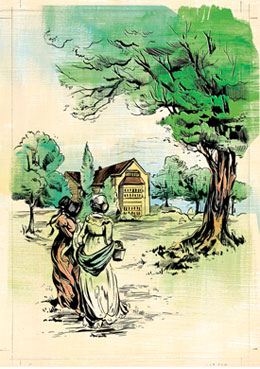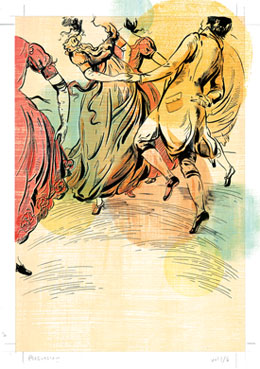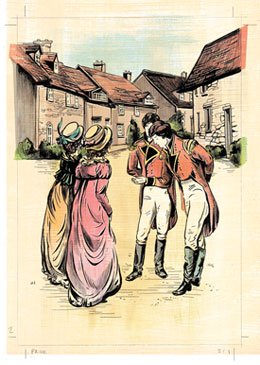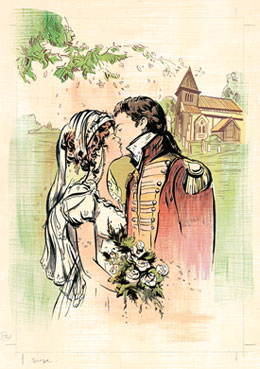
The Complete Novels of Jane Austen: Emma, Pride and Preju...
and over one million other books are available for Amazon Kindle. Learn more


Flip to back
Flip to front




The Complete Novels of Jane Austen: Emma, Pride and Prejudice, Sense and Sensibility, Northanger Abbey, Mansfield Park, Persuasion, and Lady Susan (The Heirloom Collection) Hardcover – October 2, 2012
|
If you buy a new print edition of this book (or purchased one in the past), you can buy the Kindle edition for only $0.99 (Save 86%). Print edition purchase must be sold by Amazon. Learn more. |
Start reading The Complete Novels of Jane Austen on your Kindle in under a minute.
Don't have a Kindle? Get your Kindle here, or download a FREE Kindle Reading App.
Don't have a Kindle? Get your Kindle here, or download a FREE Kindle Reading App.
Best Books of the Month
Want to know our Editors' picks for the best books of the month? Browse Best Books of the Month, featuring our favorite new books in more than a dozen categories.
Want to know our Editors' picks for the best books of the month? Browse Best Books of the Month, featuring our favorite new books in more than a dozen categories.
Product Details
Would you like to update product info or give feedback on images?.
|
Editorial Reviews
Amazon.com Review
A Look Inside The Complete Novels of Jane Austen
Click the images below for a sneak peek at the four-color illustrations inside the books.
About the Author
English novelist Jane Austen came from a close, lovingfamily and lived a quiet life. Not much biographical information about Austen exists, and much of it comes from letters written to her beloved and only sister, Cassandra, as well as accounts from family members after Austen’s death. Austen was born on December 16, 1775, as the seventh of eight children to Reverend George and Cassandra Austen. Growing up in the English village of Steventon, she was primarily educated at home, where she was surrounded by the books in her father’s library. With her parents’ encouragement, Jane began composing stories in her teens and by her twenties she had completed the first drafts of what were to become Northanger Abbey, Sense and Sensibility, and Pride and Prejudice. Through her brother, Edward, who was adopted by a wealthy, childless relative, Austen was exposed to the aristocratic life of the landed gentry. Her incisive observations of such privileged classes and the resulting social commentary are two of the many elements of her romantic fiction that still resonate today. Upon her father’s retirement, the family moved to Bath, and when her father died in 1805, she, her mother, and her sister relocated to a small house in the village of Chawton, courtesy of Edward. It was there in Chawton that Austen worked in relative solitude on her first novel, Sense and Sensibility, seeing anonymous publication, as “A Lady,” in 1811. Austen went on to publish six completed, full-length novels, still widely read, including Mansfield Park and Emma. In July 1817, she died at the age of forty-one and was buried in Winchester Cathedral, accompanied by an epitaph that doesn’t identify her as an author. Both Northanger Abbey and Persuasion were published posthumously, and her epistolary novella, Lady Susan, didn’t see publication until 1871.
More About the Author
Though the domain of Jane Austen's novels was as circumscribed as her life, her caustic wit and keen observation made her the equal of the greatest novelists in any language. Born the seventh child of the rector of Steventon, Hampshire, on December 16, 1775, she was educated mainly at home. At an early age she began writing sketches and satires of popular novels for her family's entertainment. As a clergyman's daughter from a well-connected family, she had an ample opportunity to study the habits of the middle class, the gentry, and the aristocracy. At twenty-one, she began a novel called "The First Impressions" an early version of Pride and Prejudice. In 1801, on her father's retirement, the family moved to the fashionable resort of Bath. Two years later she sold the first version of Northanger Abby to a London publisher, but the first of her novels to appear was Sense and Sensibility, published at her own expense in 1811. It was followed by Pride and Prejudice (1813), Mansfield Park (1814), and Emma (1815). After her father died in 1805, the family first moved to Southampton then to Chawton Cottage in Hampshire. Despite this relative retirement, Jane Austen was still in touch with a wider world, mainly through her brothers; one had become a very rich country gentleman, another a London banker, and two were naval officers. Though her many novels were published anonymously, she had many early and devoted readers, among them the Prince Regent and Sir Walter Scott. In 1816, in declining health, Austen wrote Persuasion and revised Northanger Abby, Her last work, Sandition, was left unfinished at her death on July 18, 1817. She was buried in Winchester Cathedral. Austen's identity as an author was announced to the world posthumously by her brother Henry, who supervised the publication of Northanger Abby and Persuasion in 1818.
Customer Reviews
Most Helpful Customer Reviews
61 of 69 people found the following review helpful
By
Epilady
on November 13, 2012
Format: Hardcover
5 Comments
Sending feedback...
The quality of this collection is pretty decent. They are hardbacks and the bindings look to be sturdy. The "ribbon" for a bookmark placement is a nice homage to the era, as is the interior of the box.
I am a Jane veteran, and have read her stories throughout the years. I personally don't find the illustrations add much value. They aren't always of essential scenes or of sufficient quantity that they add much to the books. I prefer the leatherbound series offered by a competitor. However, it's difficult to get Lady Susan in hardback or leatherbound. If you're not familiar with Lady Susan, it's definitely worth a read - it tells the story using documents (letters, diary entries, etc) - and one of her wittiest "novels".
It's also difficult to justify this price for a non-leatherbound item for literary works that are in the public domain. If a reader isn't tied to a physical book, all of the titles can be read via an e-reader for very low cost or free.
For die-hard collectors, it's not a "must have" item. However, if there is someone just starting to discover Ms Austen's work, this would be a decent gift set.
I am a Jane veteran, and have read her stories throughout the years. I personally don't find the illustrations add much value. They aren't always of essential scenes or of sufficient quantity that they add much to the books. I prefer the leatherbound series offered by a competitor. However, it's difficult to get Lady Susan in hardback or leatherbound. If you're not familiar with Lady Susan, it's definitely worth a read - it tells the story using documents (letters, diary entries, etc) - and one of her wittiest "novels".
It's also difficult to justify this price for a non-leatherbound item for literary works that are in the public domain. If a reader isn't tied to a physical book, all of the titles can be read via an e-reader for very low cost or free.
For die-hard collectors, it's not a "must have" item. However, if there is someone just starting to discover Ms Austen's work, this would be a decent gift set.
Thank you for your feedback.
If this review is inappropriate, please let us know.
Sorry, we failed to record your vote. Please try again
17 of 19 people found the following review helpful
By
Jaylia3
TOP 1000 REVIEWER on December 22, 2012
Format: Kindle Edition
Verified Purchase
Comment
Sending feedback...
Of course Jane Austen's novels merit 5 stars, and this particular ebook set is a very nice compilation of all them, including Lady Susan. While free versions of Austen's work abound, the advantage to this set is having the ability to move around easily inside the books. With plenty of links and navigating features, a simple swipe or touch allows you to go from book to book or chapter to chapter. There are not a lot of illustrations, but the ones the books have display nicely even on a black and white Kindle screen.
Thank you for your feedback.
If this review is inappropriate, please let us know.
Sorry, we failed to record your vote. Please try again
17 of 20 people found the following review helpful
By
Alice Alon
on November 21, 2012
Format: Hardcover
Verified Purchase
Comment
Sending feedback...
I am extremely happy with this set! A price that was outstanding! For a magnetic box, all the books (in hard cover!) All with gorgeous covers. I am extremely happy. Anyone that is a lover of Jane Austen or reading should buy this set!
Thank you for your feedback.
If this review is inappropriate, please let us know.
Sorry, we failed to record your vote. Please try again
4 of 4 people found the following review helpful
By
Beverly D. Flores
on July 12, 2013
Format: Hardcover
Verified Purchase
Comment
Sending feedback...
These books are simply beautiful, everything from the box that houses them to pages themselves. the books are embossed and each is a lovely pale shade of color and adorned with roses, scroll work and a ribbon bookmark. They are very large and heavy books and fit beautifully in their box. The box itself is adorned with quotes and beautiful silhouettes of a chandelier, horse and carriage and tea table with chairs. Beautiful to display and to read. I am delighted.
Thank you for your feedback.
If this review is inappropriate, please let us know.
Sorry, we failed to record your vote. Please try again
5 of 6 people found the following review helpful
By
Brewton Baby
on December 20, 2012
Format: Kindle Edition
Verified Purchase
Comment
Sending feedback...
I have accumulated several Jane Austen ebooks from a variety of sources, most of which have been sitting somewhere on a cloud, unopened. I gladly purchased this one for my Kindle library, because it is optimized for taking advantage of the Kindle features across all my readers. Now I can delete the previously acquired Jane Austen ebooks as I come across them. Four stars (it is an inanimate object, after all - hard to "love" it).
Thank you for your feedback.
If this review is inappropriate, please let us know.
Sorry, we failed to record your vote. Please try again
4 of 5 people found the following review helpful
By
Jaclyn K. Weber
on December 6, 2012
Format: Hardcover
Verified Purchase
Comment
Sending feedback...
These books are very nice with illistrations throughout the books too! I bought these as a Chirstmas gift on Cyber Monday (as they were cheaper than buying each book separately), but now I am starting to want to keep them for myself as I own all of Jane Austen in one volume and prefer having each book separate.
Thank you for your feedback.
If this review is inappropriate, please let us know.
Sorry, we failed to record your vote. Please try again
1 of 1 people found the following review helpful
By
L. Halvorson
on February 18, 2014
Format: Hardcover
Verified Purchase
Comment
Sending feedback...
I am happy with this set of novels because I love Jane Austen's wit and satire and the old-fashioned appearance of the covers and pictures. The print is large enough for me, which is always a concern when I order books online, but it seemed to me that the pages were not very securely fastened to the bindings. I had to be extremely careful in handling them and will therefore not be too eager to lend them out!
Thank you for your feedback.
If this review is inappropriate, please let us know.
Sorry, we failed to record your vote. Please try again
1 of 1 people found the following review helpful
By
Stephanie Grigsby
on November 20, 2013
Format: Hardcover
Verified Purchase
Comment
Sending feedback...
Love and adore this box set! The only issue I had though was that the box was ripped from the sides but since I work at a library, that's not a problem for me to fix. Thank you sooooooo much! ^_^
Thank you for your feedback.
If this review is inappropriate, please let us know.
Sorry, we failed to record your vote. Please try again

















